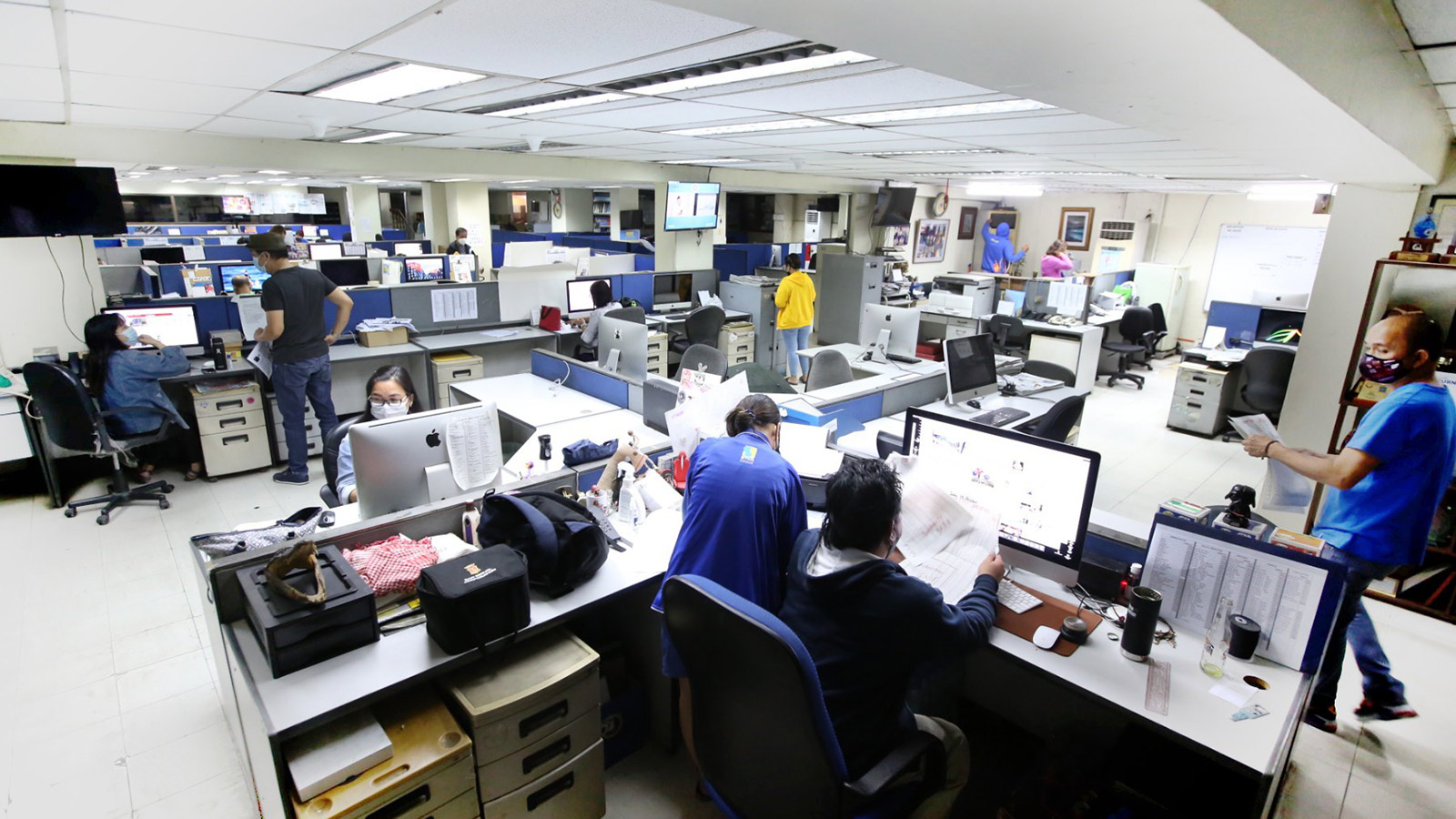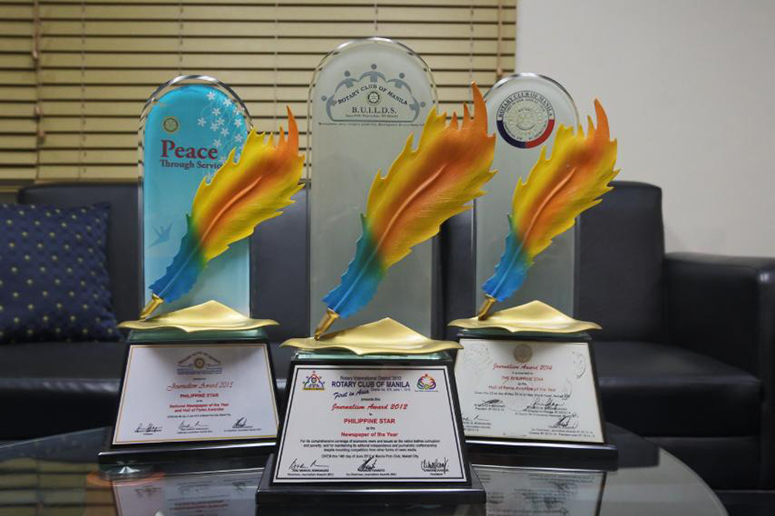Who We Are
Keeping the lights on

Every day without fail, when the last hour of light before sunset is just about to pass, a small army of men — a dozen or two — literally start the press, gathering in a high-ceilinged portion of a decrepit building right in the heart of the chaotic, maze-like Port Area district in Manila, to begin another long, arduous night of press work.
Welcome to The Philippine STAR's headquarters along Roberto Oca St. in the dizzying and labyrinthine area situated on the tip of the capital city, by the waters of Manila Bay. That the newspaper's home lies on the street named after the labor leader Roberto Oca is mere coincidence, but it fits perfectly well.
This is what makes journalism a vocation, more than a profession. It's not an eight-to-five job. There's no escaping the call of duty, whatever the weather, whatever the time, and wherever the story breaks.
Every issue of The STAR after all, is woven out of the blood, sweat and tears of every man and woman working for the newspaper — from the men who run the printing press, to the layout artists, the advertising account executives, the accountants, the proofreaders, the indefatigable reporters, the tireless editors and the rest of the team.
A newspaper isn't one man's job, indeed; it can never be. From planning the stories to putting the whole thing to bed, the work is serious, fast-paced, oftentimes heartbreaking and very much time consuming. It is never for the fainthearted or for those who easily break.
The stories are endless as they are varied and the biggest ones come when they're least expected — at night just when the world is about to fall asleep or past midnight when an overseas Filipino worker about to be hanged gets a reprieve, or at the break of dawn when a dictator and his family are forced to flee in exile.
It's partly the reason newsmen are among the most complicated people on earth —always chasing stories no matter the hours, have no holidays and are usually absent or late at the dinner table because of the rigors of the job.

There are no office hours because the news business does not sleep. In fact, some stories break in the most unexpected moments — like a thief in the night.
This is what makes journalism a vocation, more than a profession. It's not an eight-to-five job. There's no escaping the call of duty, whatever the weather, whatever the time and wherever the story breaks.
'Wear yellow and die'
Journalism, many say, is history in a hurry and The STAR's kind of journalism is no exception. It was born on July 28, 1986 to veteran journalists Betty Go-Belmonte, Max Soliven and Art Borjal, making it one of several Philippine newspapers founded after the 1986 People Power Revolution.
Its first issue had no advertisement and had just eight pages. But it was enough to make its mark in a country struggling to break free from the cudgels of the dictatorship at the time, with its maiden headline “Wear yellow and die.”

The story featured the death of a bystander, 23-year-old Stephen Salcedo, killed by a mob of Marcos loyalists during a rally at Manila's Luneta Park.
The masthead of the newspaper carried the motto, “Truth Shall Prevail,” reflecting its editorial policy of presenting both sides of the story instead of just out-scooping everyone.
Through the years, with every story churned out, the men and women behind the newspaper continue to espouse the values and foundations with which the late Betty Go-Belmonte founded The STAR.
“When Chino Roces, Art (Borjal) and Max (Soliven) asked me to put up The Philippine STAR in 1986, I agreed on certain conditions. First, that our paper should not follow the prevailing scoop mentality, but strive to be accurate and fair… Another policy I asked for was that we always present two sides to every story and if the paper was successful, we should not scream about it...The STAR is sometimes late in exposes because we always want to present two sides but there have been many occasions when I was glad we were a bit late because our stories were more fair and accurate. The STAR is cautious with stories that involve the reputations of people. But when it comes to standing up to principles, we are bold," said Betty Go-Belmonte in an interview with Jade Lopez published in 2012.
When Belmonte died in 1994, her son Miguel “MGB” Belmonte became executive vice president.
In 1998, the Board of Directors unanimously appointed Miguel Belmonte as president and CEO, while Soliven remained as chairman of the Board of directors and publisher.
Boss Miguel led the newspaper through its glory years and toward the digital age, with its website philstar.com, making its debut in 2000. In the same year, the company began using the computer-to-plate printing system.
There have been many other changes since then. The rest, as they say, is history.
Best of the best
Today, the newsroom is headed by veteran journalist Ana Marie “Amy” Pamintuan as current editor-in-chief, with Isaac Belmonte heading the editorial board.

In all, The STAR's journey has not been easy as the newspaper — both as a public service and as a business — consistently found itself in a perennial rollercoaster ride, along with the country's never ending journey as a nation, with all the political upheavals, economic crises, sorrows and joys, defeats and victories.
And yet, through the years, with every story churned out, the men and women behind the newspaper continue to espouse the values and foundations with which the late Betty Go-Belmonte founded The STAR.


The newspaper is proud to have in its team some of the best journalists in the country led by Pamintuan herself; some of the country's finest literary writers including Juaniyo Arcellana, Butch Dalisay, Doreen Yu; renowned entertainment columnist who blazed the trail for everyone, the late Ricky Lo, and Palanca awardees led by Wilson Lee-Flores.
Its roster of Op-Ed columnists include some of the sharpest and fearless opinion writers in the country— Jarius Bondoc, Cito Beltran, Alex Magno, Elfren Cruz, Federico Pascual, Satur Ocampo, National Artist F. Sionil Jose, Amb. to the US Jose Romualdez and Danton Remoto.
The main section, also known as the National Section, led by Pamintuan, Romel Lara and Marichu Villanueva, has a team of close to 30 reporters pounding the different beats, day in and day out, some of whom have been recognized by different award winning bodies.

Alexis Romero is one of the section's widely-read reporters.
“Most of my exclusive stories for The STAR were about the military's modernization program. When I was assigned to the defense beat, I brought with me my penchant for stories involving taxpayers' money.
“The timing was also right because I covered the defense beat while the Philippines was dealing with China's aggressive expansion in the West Philippine Sea. Any effort to upgrade the military's external defense capability was considered a significant development.
“Thanks to our reliable sources in the Defense department, The STAR was the first media outlet to report about some key developments in plans to acquire a number of military assets and equipment like strategic sealift vessels, attack helicopters, long range patrol aircraft, anti-submarine helicopters, and basing support systems,” shared Romero, a recipient of the Trinity University of Asia Platinum Stallion best male print reporter award in 2017.
Another reporter from the national section, Janvic Mateo, was named 2019 fellow of the Reham Al-Farra Memorial Journalism Fellowship of the United Nations.
He also consistently covered one of the biggest stories in the country, the 2009 Maguindanao massacre.

“Over the past nine years, I have been assigned to cover numerous beats and stories, but the most memorable for me is the 2009 Maguindanao massacre trial that culminated with the promulgation of judgment last Dec. 19, 2019,” said Mateo who covers education and human rights.
Another widely-read reporter in the section is Paolo Romero, who has covered many beats in The STAR, including local police and trial courts, the Catholic church, as well as the defense and security sector, and Malacañang.
“I recall covering the canonization rites for a saint in the Vatican sometime in 2007 as part of a presidential coverage. We were deployed early that day on a rooftop overlooking St. Peter’s Square where the ceremony will be held in the afternoon. For security reasons, we, along with journalists from other countries, were not allowed to leave until after the event. Hours before the event started, it rained. It was good I had a small umbrella in my backpack. So there I was, standing and drenched for hours, with my umbrella in my armpit so I could use both hands to type my story in my phone,” shared Romero, who was named Best Newspaper Male Reporter of the Year in the Centennial Journalism Awards of Rotary Club of Manila in 2019.
The STAR’s Business Section, led by veteran economic journalist Marianne Go, meanwhile, is known in the business community as a reliable source of business news. Its columnists, led by Boo Chanco, are among the most sought-after in the country.

It is the first to be named “Best News Source” by the Economic Journalists Association of the Philippines (EJAP) in 2011, winning the same award again in 2015. Its roster of business reporters are also consistent EJAP awardees.
Catherine Talavera, one of the younger business reporters, said that despite the spread of online news outlets, The STAR remains a reliable source of information for public officials and relevant authorities.
“For instance, a story I wrote about power restoration efforts in Metro Manila, which was originally published in print, made its way on social media sites and was even shared by Pasig Mayor Vico Sotto on his social media accounts,” she said.
The section has also won regional awards including First Place in the Development Asia Journalism Award from Tokyo-headquartered Asian Development Bank , which this writer won in 2013 for the story “More needs to be done for regional integration.”
The Lifestyle Section is headed by Millet Martinez Mananquil, a veteran lifestyle journalist and writer with charming prose.
The Entertainment section is now under its editor Nathalie Tomada, a Konrad Adenauer fellow, who worked closely and learned many tricks of the trade from Ricky Lo.
The Sports Section is the readers’ “breakfast dose of the tests and travails and pains and gains and triumph of the human spirit,” said its long-time editor Lito Tacujan who retired in 2018.
We had our share of covering the greats and The Greatest, the emergence of Manny Pacquiao who displayed the courage and heart of the Filipino, five Olympic Games with Onyok Velasco’s silver medal finish in Atlanta 1996 one of the highlights,” he said in 2018.
Meanwhile, Sports editor Nelson Beltran is currently in Tokyo hounding the beat for medal yields of the Philippine delegation in this year’s version of the global sporting spectacle.
The STAR, indeed, has come a long way since publishing its first issue on that fateful, tumultuous day in 1986. It has expanded with newer, specialized and featurized sections including Property Report, which covers real estate; and Wheels, which focuses on the automotive industry.
It is a rich source of information for every man, woman and child in this nation of 110 million, a daily recording of all of the nation’s travails and never-ending quest for hope, justice and triumph.
Today, the STAR celebrates this feat with heartfelt gratitude to our readers who continue to be with us in this journey as we keep the lights on, day in and day out and through the country’s darkest periods and most fabled moments.



